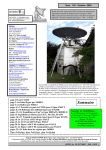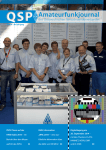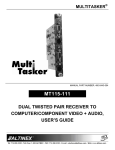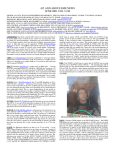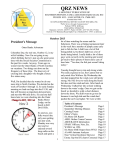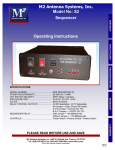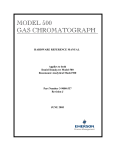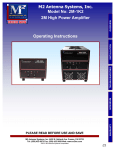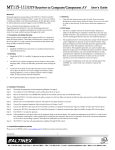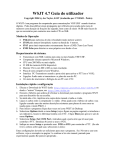Download Welcome to 6M EME Today
Transcript
Welcome to 6M EME Today! 6m Longest Path Comes of Age by Lance Collister, W7GJ June, 2010 The author manually aiming his 6m EME array from the base of the tower. INTRODUCTION 50 Mhz is arguably one of the LEAST suitable and most challenging bands for EME. Signals are almost always marginal, susceptible to geomagnetic interference, and subject to high degradation from background sky noise. But what else do you do on 6m during the solar cycle minimum, when conditions most places around the world are like they almost always are in western Montana? Don’t put away the 6m equipment for 10 years - make long path contacts instead! I mean REALLY long path contacts - like 800,000 km! Many 6m stations or DXpeditions think they don't have a station capable of EME (EarthMoon-Earth communications, or "moonbounce"), and therefore never consider trying it. But many who are willing to try it are surprised to learn that they actually do have the capability of sending signals to the moon and back. Working REAL long path on 50 MHz is now very possible and unquestionably brings magic back to the "Magic Band" – no matter where we are in the solar cycle or how poor the solar cycle turns out to be! In fact, what many term “poor band conditions” actually are the most ideal EME conditions! In the three decades since the first 50 MHz amateur moonbounce contact between the teams of Dick Allen (W5SXD) and Joe Muscanere (WA5HNK - now W5HNK) in Texas, and Connie Marshall (K5WVX - now K5CM) and Sam Whitley (W5WAX - now K5SW) in Oklahoma, the playing field has changed dramatically. That historic contact utilized a pair of 8 yagi arrays, each aimed at the horizon! Previously only an option open to a very few of the world’s largest stations, moonbounce contacts are now within reach for most well-equipped 6m stations. Sure it is a challenge, but to illustrate my point, I have completed 6m EME contacts with hundreds of stations around the world, and currently have QSL cards from over 100 different DXCC worked on 6m EME over the last eight years. In this paper, I will outline some of the reasons why 6m EME has become a viable option, the station requirements, and how to successfully get started on 6m EME. I will also present a brief survey of some of the stations and antennas currently being used for 6m EME. SO WHAT MAKES 6M EME POSSIBLE NOW? Until relatively recently (spring of 2002), an accomplishment such as making a moonbounce contact on 6m EME was about an "S Unit" or two beyond the reach of most stations. And when it comes to something like 6m moonbounce, where signals are just on the threshold of detectability, 5 to 10 dB is a HUGE amount! However, several very significant developments have combined to make this out-of-thisworld type of 6m propagation practical and attractive today. 1) ANTENNAS Computer-optimized antennas have significantly improved both receive and transmit capabilities. The difference between the old ubiquitous 5 element beam of 30 years ago and the computer-optimized long boom 5 element yagi of today is substantial, and noticeable even during nonEME contacts! And for those who are not inclined to homebrew antennas, there are now some manufacturers of very high performance computer-optimized 6m antennas. Remember, you only need to aim the antenna at the horizon to work EME when the moon is rising or setting! 2) EQUIPMENT Recent developments in equipment have incorporated 6m into many new HF transceivers (some of which, such as the Elecraft K3, are even already set up for digital mode operation on 6m!), and the band is also included in a growing number of new HF amplifiers. Inexpensive power tubes from Russia have made it very easy to develop "legal limit" type of power output on 6m, and new inexpensive transistors provide excellent performance from very affordable receiver preamplifiers. The rising popularity of digital modes on HF means that many stations have the equipment to operate JT65A mode. The ready availability of such equipment has made it very easy to assemble a first class 6m EME station using “off-the-shelf” equipment. In fact, many well equipped HF stations also already have all the 6m equipment they need for 6m EME! And thanks to developments for the cell phone industry, it is easy to find low loss coax for 50 MHz that makes it possible to obtain optimum results without having towermounted preamplifiers and amplifiers. 3) WEAK SIGNAL DIGITAL MODES New weak signal digital signal processing software that can be run by Windows computers has further narrowed the gap. The very specialized weak signal mode of JT65A (included in the WSJT computer program developed by Dr. Joe Taylor, K1JT) provides an improved sensitivity of more than 10 dB compared to CW, the previous mainstay for weak signal work. This innovation has turned very difficult weak signal accomplishments like 6m EME into very real possibilities for many hams. You can very well imagine that if 6m signals were previously just below the threshold of detectability, this extra 10 dB is a huge improvement to signal strength! In fact, EME on 6m - more than on any other band - has benefited from the extra margin of sensitivity provided by JT65 mode. Any station that can transmit the popular HF mode of PSK31 can operate on JT65A mode. WSJT with a complete English language User Manual is available for free download from the WSJT Home Page. User Manuals in many other languages are also available for download there. In addition, to help bring new users up to speed, I have prepared a “quick setup” list of JT65 tips on my web page. The author operating 6m EME (the moon tie is optional equipment) 4) LESS INTERFERENCE And, of course, it doesn’t hurt one bit that many households have switched to either cable television or to satellite reception of television signals, and old 49 MHz portable phones are rapidly being displaced by inexpensive 900 MHz and 2.4 GHz portable phones. And in many parts of the world, analog TV stations near the 6m band have been shut down. The 6m band has long held the reputation as the most difficult amateur band to operate safely without causing interference. However, now many of these most vulnerable household appliances are being improved through newer technologies, making the 6m ham band much more attractive again! 5) TECHNICALLY SIMPLER 50 MHz circuits and equipment is much more tolerant to error than the higher frequencies. Most hams have fewer problems putting together an effective station at the lowest VHF band, and have all the simple test equipment necessary to keep things running. 6) LARGE ACTIVITY Because so many thousands of hams around the world already are active on 6m, it represents a large potential pool of contacts in many countries. If you are interested in reaching far corners of the world to people who already have equipment capable of contacting you, 6m becomes very attractive! 7) MULTIPLE USE Investing time and energy optimizing a station for 6m EME will pay back in other propagation modes too, since it will improve your success on Es, F2 and TEP propagation as well. 8) GREATER DX With EME, stations can be reached in unthinkably rare corners of the globe. Stations that were previously out of range, even during the most active sunspot cycles, are now potential contacts. When the geomagnetic field is quiet, conditions are the very best for 6m EME, so it is very complimentary to the F2 propagation! And the bleak predictions for the coming sunspot cycle(s) are even more incentive for 6m operators to gear up to take advantage of the natural propagation provided by the moon. 9) MODERN COMMUNICATION Certainly another significant factor in the rise of 6m EME over the last decade has been the widespread use of email and internet chat pages to most efficiently facilitate schedules and make last minute changes! As explained below, there are many complications involved in arranging appropriate times between stations for EME contacts, and frequently those wind up being in the middle of the night or during working hours, or at other times when the operators would not be likely to be at the station unless a schedule was arranged. In the past, awkward and inefficient attempts were made to set up schedules via mail or HF radio frequencies, but those also were quite inconvenient and not nearly as reliable and fast as the new communication tools available to us today! COMMON MOON WINDOWS The most basic requirement in order to contact somebody via the moon is that both stations must be able to see the moon at the same time and aim their antennas at it. Since the moon is visible to roughly half the earth at any particular time, it is possible to contact stations halfway around the world…that basically means you can contact someone anywhere in the world using moonbounce. And because the moon rises and sets every day, there are at least two times each day when you can aim your antenna at the moon without elevating it off the horizon. It is very easy to predict when you will have a "common moon window" with a station somewhere else in the world, and to see what days look like that will have the best conditions for EME. My GJTRACKER program for Windows is available for free download and quickly calculates future EME schedule possibilities. DECLINATION CHANGES Everybody knows that, because the Earth is tilted on its axis, the sun appears to move north and south in the sky over the course of the year, as we orbit the sun. Similarly, the moon moves north and south in the sky as it completes its monthly orbit around the earth. This apparent deviation (referenced with respect to an imaginary plane going through the earth’s equator) over the course of each month is called the “declination”. One result of this changing declination is that the length of the “common moon window” between two locations on the earth changes every day. What this means for moonbouncers is that you are provided at least one time each month when the moon is on the horizon for both stations at the same time, so both stations can keep their antennas on the horizon while they both are aiming at the moon. STATION REQUIREMENTS In short, a station with 1 kw output, a sensitive receiver or external preamplifier, ability to run the JT65A weak signal digital mode, good low loss feedline, and a good single yagi (over 1.5 wavelengths long) is an excellent candidate for successful 6m EME contacts. My first 6m EME contact was using a homebrew 7 element yagi only 20' above the ground. After a number of attempts during my moonrise, I finally completed a CW contact with SM7BAE who, in addition to having the largest 6m array in the world at the time, was very patient. But that was in the days before WSJT and JT65A! Although there still is nothing easy about 6m EME, using JT65A instead of CW definitely increases the chances of success considerably! Such a single yagi station should now be able to complete contacts with other similarly-sized stations when the moon is on the horizon for both stations. The simplest way to specifically assess your capabilities and target other stations you can work, is to use the very convenient "EME Calculator" that is found on the "EME ECHO MODE" screen of version 4.9.8 of the WSJT program. Whether or not your station is already wired with a computer interface unit that will allow you to operate digital modes, you can certainly download the WSJT program and run the EME Calculator! I usually suggest that a station have an antenna with 14 dBd gain if he is interested in reliably working similarly sized stations. That 14 dBd gain can include ground gain, if he is primarily interested in operating on the horizon. With 1500w output and 14 dBd from my single long yagi, I could detect my echoes more than half the time when pointed skyward and could often hear my own CW echoes weakly during good conditions. Of course, when the moon passed through my ground gain lobes during moonset or moonrise, signals were significantly louder. If you want to be able to contact stations smaller than yours, or run less power yourself, you will have to make up for the gain on your end with a larger antenna. With my array of four long yagis, I have completed contacts with numerous single yagi stations running between 400 and 600w, and with a handful of stations using only 100w. The smallest 100w station was only running a three element beam (but conditions were optimum for EME, and his location obviously afforded ideal ground gain). There currently are dozens of steerable four yagi stations around the world, which makes it easy for single yagi horizon-only stations to make EME schedules at times that coincide with their moonrise or moonset constraints. Although not necessary to hear the larger stations, if you want to be able to copy weak signals well, you will probably also will want a good, low noise external receive preamplifier. During periods of the month when EME conditions are the best, the addition of a low noise preamplifier will be a very welcome improvement at most 6m stations trying to capture the really weak signals from the moon. Most of the more popular transceivers that include 6m are optimized for handling lots of strong stations rather than being most sensitive to detect weak signals, and can benefit from the addition of an external low noise preamplifier. Most 6m EME stations use low loss feedline, so the preamplifier can be conveniently installed down next to the receiver, rather than mounted out on the tower. GROUND GAIN - USE IT TO ADVANTAGE! In my first two decades of EME, I never paid much attention to the concept of ground gain. All my early EME activity was on 2m, and my antenna was always tracking the moon to make contacts. Many stations assume they have no EME capability because they cannot elevate their antennas. However, as discussed above, there are certain times of month when two stations can see the moon on the horizon at the same time. Actually, there is a very real advantage in keeping a small antenna aimed at the horizon! A single yagi aimed at the horizon can develop additional ground gain. This is extra gain that can often make the antenna perform more like twice (or even 4 times) as many antennas! This extra 3-6 dB only is available at certain elevations, and depends on the local terrain, the ground conductivity, antenna gain and its height above the ground. The signals reflected up to the antenna create sharp “ground gain lobes”, and when the moon passes in front of one of these lobes, signals can be greatly enhanced. That is how smaller stations on 6m are able to complete EME contacts - they keep their antennas aimed on the horizon and wait for the moon to move into their ground gain lobes. Figure 1 - Ground Gain Lobes of a single 6M11JKV Beam Antenna 3.5 Wavelengths Above Ground (diagram courtesy of K0GU) Notice that the first two lobes shown for my single yagi have substantially higher gain than the third lobe. The third lobe is roughly equivalent to the “free space gain” of the antenna (how the antenna would perform if it were elevated and pointed skyward). I have completed 6m EME contacts with many single yagi stations while the moon was in their second ground gain lobe. In the example shown, the second lobe can be seen as having over 4 dB more gain compared to the third lobe, and only about 1.5 dB less gain than the lower "main" lobe! Actually, for a number of reasons (discussed below), the second ground gain lobe sometimes even works better for EME than the main lobe! The closer the antenna is to the ground (or some other large object or antenna below the antenna that looks like ground, such as a rooftop, or HF beam, etc.), the higher the ground gain lobes are raised. Conversely, the higher the antenna is above the ground, the lower the ground gain lobes. These lobes are also lowered when a station is located on a hill, or the smooth terrain is flat or dropping away in front of the antenna. It also is not unusual for an antenna that is only a few wavelengths high to have an excellent ground gain lobe around zero degrees elevation if the distant horizon is actually a negative horizon (such as looking out over the ocean). Typically, single yagi stations at locations without “ground clutter” (buildings, rooftops, cars, hills, ravines, etc.) in front of the antenna have a good ground gain lobe between about 3 and 7 degrees, and a higher lobe between about 10 and 15 degrees elevation. Because the higher lobe is more dependent on terrain closer to the antenna, and more distant terrain is often more uneven or disrupted by ground clutter, signals are often better when the moon is in the second lobe. Because of this, I usually set up schedules with single yagi horizon-only stations, making sure to include the time when their moon is a bit higher than 15 degrees elevation. That way, we can be sure to catch the moon as it moves in front of their two best ground gain lobes. When the moon signals are enhanced by the moon briefly being at the correct elevations for that particular antenna installation - and if the polarity of the signals also happens to be properly aligned - the yagi aimed at the horizon will receive the weak EME signals! You can see what a challenge 6m EME still is, especially when small horizon-only stations are involved on one or both ends of the contact. Not only does the moon have to be in front of the desirable ground gain lobes – the polarity of the incoming signals also must happen to be properly aligned at the same time! For that reason, 6m EME schedules are usually run for about an hour, providing time for the moon to move through both lower ground gain lobes. Even though the odds of EME being reciprocal are small, there is good chance that the polarity will change enough over the course of an hour to permit the information required for a complete contact to be exchanged. Beams that are stacked vertically only exhibit these same types of multiple ground gain lobes when both antennas begin to approach the same height above ground. This usually means that the center of the stacked array has to be higher than 4 or 5 wavelengths above the ground to have these same kinds of strong multiple ground gain lobes. For antennas closer to the ground than that, each beam has ground gain lobes at different elevations, so they cancel out and/or “smear” into a single broader ground gain lobe. Figure 2 shows the vertical pattern for my EME array (similar to two yagis stacked above each other) centered at approximately 1.75 wavelengths above the ground. Figure 2 - Ground Gain Lobe of W7GJ EME Array, Typical of Stacked Beam Antenna Centered 1.6 Wavelengths Above Ground (diagram courtesy of K0GU) You can see the advantage that a single yagi without elevation offers for EME - the two very good ground gain lobes offer twice as many chances for the moon to line up with a gain lobe. For an antenna that is used on the horizon, one single long yagi serves as an excellent EME antenna. 6M EME is still a very challenging endeavor with a small antenna, but if you are patient and you properly use the assets available, real magic can happen! CONDITIONS AFFECTING 6M MOONBOUNCE 6m is perhaps the worst and most unreliable band for EME, because of all the things that can adversely affect the signal propagation at 50 MHz. You can easily understand why conditions may change rapidly, and success may result only after numerous failed attempts. Since signals are usually only marginal anyway, attempts at EME should be scheduled to try to avoid as many of these disruptive factors as possible. For that reason, most of the 6m EME activity happens during times when conditions appear to be most favorable, and people generally do not waste their time running schedules during poor conditions. 1) LOCAL RECEIVER NOISE One of the most common challenges faced by 6m operators especially if they keep their antennas on the horizon - is local noise. Power line noise, interference from strong local broadcast stations, industrial noise sources, automobiles, household appliances (thermostats, motors, computers, street lights, etc.) - all can make it difficult to hear weak signals. Ideally, attempts at EME should be scheduled when local noise is at its minimum. 2) PROPAGATION INTERFERANCE Aside from local noise, there are numerous types of phenomena in the atmosphere and ionosphere that can interfere with 6m signals as they travel out to the moon and back again. Regions of High Total Electron Content (TEC) associated with TEP, as well as broad blanketing of Es, F2, aurora, and a generally disturbed geomagnetic field (a high Kp index or even a high A index) have all been found to adversely affect 6m EME signals. Local temperature inversions also can “trap” signals along the earth, rather than allowing them to head out toward the moon. Many of these adverse effects are difficult to predict in advance, while others can be avoided by picking the correct time of day, or watching space and local weather forecasts. In many cases, elevating an antenna (or using the second ground gain lobe on a single yagi aimed at the horizon) will reduce these adverse effects, by sending the signal through less atmosphere/ionosphere. Of course, the geomagnetic interference is far less, and the EME conditions are best outside the peak of the solar cycle! 3) MIS-MATCHED POLARITY Faraday rotation is rotation of the polarity of the signals as they pass through the ionosphere. Often the polarity repeats itself in about 15 minutes, but it can be “stuck” for long periods (especially during periods of low Kp index, or when both EME stations are in darkness), in which propagation will appear to be “one-way” or wrong for both stations. This is something which cannot be controlled or predicted, but needs to be anticipated. 4) DEGRADATION Perhaps the most predictable factors related to EME conditions involve those related to the orbital motion of the moon. Every month the moon moves close to the earth (perigee) and away from the earth (apogee). The difference in signal path loss between these two spots is over 2 dB - a very significant difference. On top of that, the moon also moves through quieter and noisier parts of the sky. At 6m, this background noise can be significant and easily mask the weak signals you are trying to detect. The combination of these two factors, compared to the ideal situation of the moon being at perigee and in front of a quiet sky, is called the amount of “degradation”. An estimate of this degradation is shown on the JT65A screen, as well as in my GJTRACKER moontracking program. MAKING CONTACTS Because signals are so weak, and there are so many stations who do not have full moon tracking antennas, there is almost no random activity on 6m EME. Contacts are usually made by setting up schedules via email, or through dedicated real-time EME websites or chat pages such as such as the N0UK JT65 EME , the ON4KST 6m CHAT or the ON4KST EME CHAT pages . Because of the relatively small number of stations active at any given time, and the various operating and propagation conditions that have to be taken into consideration, making schedules usually seems to make the most sense. Virtually all current 6m EME activity uses the weak signal JT65A mode, which does best without any QRM, so frequencies are agreed to well in advance, and frequencies with known or expected activity or birdies are avoided. Typically, all 6m EME activity takes place between 50.180 and 50.220 MHz. In addition, there are other local band use plans and government regulations that further restrict the use of digital modes and/or EME weak signal operation, so a suitable frequency often has to be coordinated in advance, depending on where each of the stations is located. In cases in which many stations calling a DXpedition station, the callers typically coordinate among themselves via the internet, and spread out every 200 Hz. Since the total bandwidth of a JT65A signal is under 200 Hz, this assures that there will be minimal interference between callers. ACTIVE STATIONS Obviously, it is impossible to track of all the stations currently active on 6m EME, because things are changing all the time. In Table 1, I have attached a list showing some of the stations who recently have been on the air. As you can see, most stations keep their antennas aimed on the horizon and utilize ground gain to achieve EME capability. However, there are a growing number of stations expanding the size of their antennas and adding elevation capability so they can greatly expand their common moon windows with other stations. With the growing popularity of digital modes on HF, there is an ever-increasing number of stations capable of operating 6m EME. Also, with the declining solar activity, an increasing number of 6m DXpeditions are adding 6m EME to their toolkits. Over half of my Magic Band DXCC have been worked using EME, and many of those (including CY9DH, ES8X, OJ0LA, V36M, 9U0A, 7P8NK, EA8/G8BCG, 9A8A, OX3LX, GJ8BCG/P, ZL8R, KH0/KH2K, CN3A, V51W, 9N7JO, P29NI, TO5E, IS0/I0JU, 6W1SE, DX0JP, J68AS, 5A7A, OM3RRC, D44TD, ST2RS, YA1RS, 4X/ZL1RS, N8S, TZ6EI, Z31RM, C37NL, JD1BMM. K5D, EX7MW, 4O3A, XE2AT, 8Q7QQ, etc.) have been from 6m EME contacts with DXpeditions or portable operations. An effective way to find potential schedule partners is to watch announcements of upcoming DXpeditions or on stations checked into the internet 6m activity pages. Another way is to watch for "spots" on the DX Cluster of 6m stations currently being heard on EME. THE FIRST STEP - TESTING FOR ECHOES If you are interested in determining if your station is capable of 6m moonbounce, you can start by simply listening for your own echoes. Just send a few dashes on CW when the moon is near the horizon passing through your ground gain lobes on a day with very low degradation, and see if you can hear your signals returning from the moon approximately 2.5 seconds later. Don’t become too discouraged if you don't hear them right away, or if they are not very consistent - as you can see from above, there are lots of factors that will cause them to come and go! If you can detect your own CW echoes, you most certainly can contact similarly sized stations under similar conditions. If you are set up for digital modes, the easiest way to test for echoes is to use the WSJT “EME ECHO MODE”. This mode will automatically test for your echoes and display a record of precisely how well they were detected. RESOURCES There are many links on my website for anyone interested in learning more about JT65A or 6m EME. In addition, there is a “Magic Band Email Reflector” that folks can use to exchange ideas and answer questions. I am happy to help interested newcomers connect to any such resources. The following are some links to provide a starting point for those interested in specifics regarding some of the subjects discussed above: 6m Preamplifiers: http://www.hamtronics.com http://www.elecraft.com/PR6/pr6.htm HF/6m kw power amplifiers: http://www.hfpower.com/new/a1000.htm http://www.yaesu.com/indexVS.cfm?cmd=DisplayProducts&ProdCatID=102&encProdID=47ZAY%2Bq 1XfE%3D&DivisionID=65&isArchived=0 http://www.icomamerica.com/amateur/amps/index.html http://www.rfconcepts.com/PRODUCTS Dedicated 6m power amplifiers: http://home.cshore.com/lunarlink/ http://www.command1.com/products.htm http://www.intertronicsolutions.com/amateur/ http://www.pollak.sulinet.hu/elektro/pa_rev/pa_rev.htm#high_vhf http://www.tesystems.com/ Computer-Optimized 6m Antennas: http://www.m2inc.com/index2.html http://www.tridentantennas.co.uk/Frames/Mainframe.htm http://www.directivesystems.com/antenna4.htm http://www.yu7ef.com/ Free moontracking program to calculate common window times and degradation: http://www.bigskyspaces.com/w7gj/tracker.htm Free WSJT digital communications program for JT65A mode weak signal work: http://www.physics.princeton.edu/pulsar/K1JT/wsjt.html Interface units between computer and radio to operate digital modes: http://www.westmountainradio.com/ Free programs to simply display received audio spectrum: http://digilander.libero.it/i2phd/spectran.html More information about 6m EME and using digital modes: http://www.bigskyspaces.com/w7gj/JT65checklist.htm http://www.bigskyspaces.com/w7gj/JT65.pdf http://www.bigskyspaces.com/w7gj/ http://www.on4kst.com/ CONCLUSION Although 6m EME is very challenging and unpredictable, it also is very fulfilling and exciting when it works! And, for me, it is a very welcome alternative to ionospheric propagation, which comes along far less often out here in Montana! If you want to experience some real magic, even when you think the 6m band is "closed", consider giving 6m moonbounce a try! You just might be very pleasantly surprised at the DX you can work! See you off the moon! On 6m EME, the Magic never ends... TABLE 1. Below is a survey of some larger or more active 6m EME stations as of June 1, 2010. The key to the STATUS code is: A= frequently Active, B= capable of getting on 6m EME, C= under Construction CALLSIGN K6QXY K6MYC ON4GG ON4IQ W1JJ W7GJ SM7FJE W6BVB WX7M JR6EXN K5GW WA4NJP IW5DHN K2LZQ K2ZD K7AD OK1RD K1WHS PE1BTX W7ALW KS7DX ES6RQ G5WQ K1SG N6RMJ OH2BC N8CJK VE5UF K9KL JA1RJU OH7PI N0RI KH7Y JG2BRI ZS6WAB ANT 8x5 4x9 4x9 4x9 4x9 4x9 4x9 4x9 4x9 4x8 4x8 4x8 4x7 4x7 4x7 4x7 4x7 4x7 4x7 4x7 4x7 4x6 4x5 4x5 4x5 4x5 4x5 4x5 3x7 2x14 2x10 2x9 2x8 2x8 2x8 EL Y Y Y Y Y Y Y Y Y Y Y Y Y Y Y Y Y N Y Y N Y Y Y Y Y Y Y N Y N N Y Y Y STATUS A A A A A A B B C A B B A A A A A B B B C B A A A A C C A A B B A B B CALLSIGN W7CE K7XQ KR7O W8PAT K7CW SM7SJR G4IGO ZL3TY G1OAR G8VR KJ9I ZS6NK G4FUF GD0TEP K4RX VE1JF S57RR ZL3NW LY2BAW N5DG ON4KST UN8GC XE2AT CT1HZE XW1B OH6MIK S57RR V51PJ F6BKI F6FHP KG6DX OZ4VV VK4CZ K0XXX G8BCG ANT 2x8 2x7 2x7 2x7 2x7 2x7 2x6 2x6 2x5 2x5 1x13 1x11 1x11 1x11 1x11 1x11 1x10 1x10 1x10 1x10 1x10 1x10 1x10 1x10 1x10 1x9 1x9 1x9 1x9 1x9 1x9 1x9 1x9 1x9 1x8 EL Y Y N Y Y Y Y N Y N N N N N N N Y N N N N N N N N N Y N N N N N N N N STATUS C A B B C C A A B B B A B B B C A A B B B B B C C A A A B B B B B C A CALLSIGN OA4TT K7BV ZL1RS VP8DMH E51WL GM4WJA MM0AMW N8JX OK1DO PA5JS S57TW TN5SN EA8/G8BCG K9MU KB7Q LA8AJA LX1FX N8OC SV8CS VK7JG W7IUV YU7EF OZ3ZW A92IO KG6DX KL7NO OY3JE PE1L W5UWB A92IO XV1X KH9/WA2YUN LA4ANA N3CXV VK6KXW ANT 1x8 1x8 1x8 1x8 1x7 1x7 1x7 1x7 1x7 1x7 1x7 1x7 1x7 1x7 1x7 1x7 1x7 1x7 1x7 1x7 1x7 1x7 1x6 1x6 1x6 1x6 1x6 1x6 1x6 1x6 1x6 1x5 1x5 1x5 1x5 EL N Y N N N N N N N N N N N N Y N N N N N N N N N N N N N N N N N N Y N STATUS A B B C A A A A A A A A B B B B B B B B B B A B B B B B B C C A A A B












